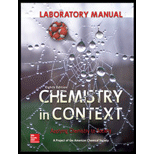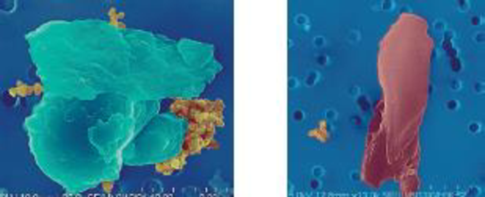
Laboratory Manual Chemistry in Context
8th Edition
ISBN: 9780073518121
Author: American Chemical Society
Publisher: McGraw-Hill Education
expand_more
expand_more
format_list_bulleted
Concept explainers
Textbook Question
Chapter 1, Problem 53Q
Here are two scanning electron micrograph images of particulate matter, courtesy of the National Science Foundation and researchers at Arizona State University. The first is of a soil particle and the second of a rubber particle, and each is about 10 μm in diameter.

(both) Source: National Science Foundation, Courtesy of Xin Hua & James Anderson
- a. Suggest a likely source of the rubber particle. Name two other substances that might contribute PM to the air.
- b. The soil particle is composed mainly of silicon and oxygen. What other elements are commonly present in the rocks and minerals in Earth’s crust?
- c. What about these photographs suggests that these particles would inflame your blood vessels?
Expert Solution & Answer
Want to see the full answer?
Check out a sample textbook solution
Students have asked these similar questions
How to name hydrocarbons
Please do these questions within the SCH4U course please with full steps since I am still unsure how to format my answers! Thank you so much.
When two solutions, one of 0.1 M KCl (I) and the other of 0.1 M MCl (II), are brought into contact by a membrane. The cation M cannot cross the membrane. At equilibrium, x moles of K+ will have passed from solution (I) to (II). To maintain the neutrality of the two solutions, x moles of Cl- will also have to pass from I to II. Explain this equality: (0.1 - x)/x = (0.1 + x)/(0.1 - x)
Chapter 1 Solutions
Laboratory Manual Chemistry in Context
Ch. 1.1 - Prob. 1.2CTCh. 1.1 - The air is different in a pine forest, a bakery,...Ch. 1.1 - Scientific Practices More Oxygen ? We live in an...Ch. 1.2 - Prob. 1.5SCCh. 1.3 - Sulfur dioxide (SO2) is released in the air when...Ch. 1.4 - Prob. 1.9YTCh. 1.5 - Prob. 1.10CTCh. 1.6 - Prob. 1.11YTCh. 1.11 - Prob. 1.19YTCh. 1.11 - Prob. 1.21YT
Ch. 1.12 - Summarize what you have learned about ozone...Ch. 1.13 - Prob. 1.27YTCh. 1.13 - Prob. 1.28YTCh. 1.13 - Prob. 1.29SCCh. 1.13 - Prob. 1.30YTCh. 1.13 - Prob. 1.35CTCh. 1 - Prob. 1QCh. 1 - Prob. 2QCh. 1 - Prob. 3QCh. 1 - Identify three sources of particulate matter found...Ch. 1 - Prob. 5QCh. 1 - Prob. 6QCh. 1 - In these diagrams, two different types of atoms...Ch. 1 - Prob. 8QCh. 1 - Prob. 9QCh. 1 - Prob. 10QCh. 1 - Prob. 11QCh. 1 - Prob. 12QCh. 1 - Prob. 13QCh. 1 - Consider the following blank periodic table. a....Ch. 1 - Classify each of these substances as an element, a...Ch. 1 - Prob. 16QCh. 1 - Hydrocarbons are important fuels that we burn...Ch. 1 - Prob. 18QCh. 1 - Arrange these types of radiation in order of...Ch. 1 - These questions relate to the combustion of...Ch. 1 - Balance these equations in which ethane (C2 H4)...Ch. 1 - Prob. 22QCh. 1 - Count the atoms on both sides of the equation to...Ch. 1 - Prob. 24QCh. 1 - Nail polish remover containing acetone was spilled...Ch. 1 - Prob. 26QCh. 1 - Prob. 27QCh. 1 - Prob. 28QCh. 1 - Prob. 29QCh. 1 - Prob. 30QCh. 1 - A headline from the Anchorage Daily News in Alaska...Ch. 1 - Prob. 32QCh. 1 - Consider how life on Earth would change if the...Ch. 1 - Prob. 34QCh. 1 - Prob. 35QCh. 1 - Prob. 36QCh. 1 - Prob. 37QCh. 1 - Prob. 38QCh. 1 - Prob. 39QCh. 1 - Prob. 40QCh. 1 - Prob. 41QCh. 1 - Prob. 42QCh. 1 - Prob. 43QCh. 1 - Prob. 44QCh. 1 - Prob. 45QCh. 1 - Prob. 46QCh. 1 - Prob. 47QCh. 1 - Prob. 48QCh. 1 - Prob. 49QCh. 1 - Mercury, another serious air pollutant, is not...Ch. 1 - The EPA oversees the Presidential Green Chemistry...Ch. 1 - Prob. 52QCh. 1 - Here are two scanning electron micrograph images...Ch. 1 - Prob. 54QCh. 1 - Prob. 55QCh. 1 - Prob. 56QCh. 1 - Prob. 57QCh. 1 - You may have admired the beauty of hardwood...Ch. 1 - Prob. 59Q
Additional Science Textbook Solutions
Find more solutions based on key concepts
What are the cervical and lumbar enlargements?
Principles of Anatomy and Physiology
1. Rub your hands together vigorously. What happens? Discuss the energy transfers and transformations that take...
College Physics: A Strategic Approach (3rd Edition)
How does the removal of hydrogen atoms from nutrient molecules result in a loss of energy from the nutrient mol...
SEELEY'S ANATOMY+PHYSIOLOGY
Why is it unlikely that two neighboring water molecules would be arranged like this?
Campbell Biology (11th Edition)
Give the IUPAC name for each compound.
Organic Chemistry
Knowledge Booster
Learn more about
Need a deep-dive on the concept behind this application? Look no further. Learn more about this topic, chemistry and related others by exploring similar questions and additional content below.Similar questions
- Calculate the variation in the potential of the Pt/MnO4-, Mn2+ pair with pH, indicating the value of the standard potential. Data: E0 = 1.12.arrow_forwardGiven the cell: Pt l H2(g) l dis X:KCl (sat) l Hg2Cl2(s) l Hg l Pt. Calculate the emf of the cell as a function of pH.arrow_forwardThe decimolar calomel electrode has a potential of 0.3335 V at 25°C compared to the standard hydrogen electrode. If the standard reduction potential of Hg22+ is 0.7973 V and the solubility product of Hg2Cl2 is 1.2x 10-18, find the activity of the chlorine ion at this electrode.Data: R = 8.314 J K-1 mol-1, F = 96485 C mol-1, T = 298.15 K.arrow_forward
- 2. Add the following group of numbers using the correct number of significant figures for the answer. Show work to earn full credit such as rounding off the answer to the correct number of significant figures. Replace the question marks with the calculated answers or write the calculated answers near the question marks. 10916.345 37.40832 5.4043 3.94 + 0.0426 ? (7 significant figures)arrow_forwardThe emf at 25°C of the cell: Pt l H2(g) l dis X:KCl (sat) l Hg2Cl2(s) l Hg l Pt was 612 mV. When solution X was replaced by normal phosphate buffer solution with a pH of 6.86, the emf was 741 mV. Calculate the pH of solution X.arrow_forwardIndicate how to calculate the potential E of the reaction Hg2Cl2(s) + 2e ⇄ 2Hg + 2Cl- as a function of the concentration of Cl- ions. Data: the solubility product of Hg2Cl2.arrow_forward
- How can Beer’s Law be used to determine the concentration in a selected food sample. Provide an in-depth discussion and examples of this.arrow_forwardb) H3C- H3C Me CH 3 I HN Me H+arrow_forwardUsing Luther's rule, determine the reference potentials of the electrodes corresponding to the low stability systems Co³+/Co and Cr²+/Cr from the data in the table. Electrodo ΕΝ Co²+/Co Co3+/Co²+ -0,28 +1,808 Cr³+ / Cr -0,508 Cr3+ / Cr²+ -0,41arrow_forward
- The molecule PYRIDINE, 6tt electrons and is there pore aromuntre and is Assigned the Following structure contenus Since aromatk moleculey undergo electrophilic allomatic substitution, Pyridine should undergo The Following reaction + HNO3 12504 a. write all of the possible Mononitration Products that could Result From this roaction Based upon the reaction the reaction mechanism determine which of these producty would be the major Product of the hegetionarrow_forwardUsing Benzene as starting materia Show how each of the Following molecules could Ve synthesked 9. CHI d. 10450 b 0 -50311 ८ City -5034 1-0-650 e NO2arrow_forwardBA HBr of the fol 1)=MgCI 2) H₂O major NaOEt Ts Cl Py (pyridine) 1) 03 2) Me2S 1arrow_forward
arrow_back_ios
SEE MORE QUESTIONS
arrow_forward_ios
Recommended textbooks for you
 Chemistry for Engineering StudentsChemistryISBN:9781285199023Author:Lawrence S. Brown, Tom HolmePublisher:Cengage LearningChemistry: Matter and ChangeChemistryISBN:9780078746376Author:Dinah Zike, Laurel Dingrando, Nicholas Hainen, Cheryl WistromPublisher:Glencoe/McGraw-Hill School Pub Co
Chemistry for Engineering StudentsChemistryISBN:9781285199023Author:Lawrence S. Brown, Tom HolmePublisher:Cengage LearningChemistry: Matter and ChangeChemistryISBN:9780078746376Author:Dinah Zike, Laurel Dingrando, Nicholas Hainen, Cheryl WistromPublisher:Glencoe/McGraw-Hill School Pub Co Chemistry & Chemical ReactivityChemistryISBN:9781337399074Author:John C. Kotz, Paul M. Treichel, John Townsend, David TreichelPublisher:Cengage Learning
Chemistry & Chemical ReactivityChemistryISBN:9781337399074Author:John C. Kotz, Paul M. Treichel, John Townsend, David TreichelPublisher:Cengage Learning Chemistry & Chemical ReactivityChemistryISBN:9781133949640Author:John C. Kotz, Paul M. Treichel, John Townsend, David TreichelPublisher:Cengage Learning
Chemistry & Chemical ReactivityChemistryISBN:9781133949640Author:John C. Kotz, Paul M. Treichel, John Townsend, David TreichelPublisher:Cengage Learning
 Chemistry for Engineering StudentsChemistryISBN:9781337398909Author:Lawrence S. Brown, Tom HolmePublisher:Cengage Learning
Chemistry for Engineering StudentsChemistryISBN:9781337398909Author:Lawrence S. Brown, Tom HolmePublisher:Cengage Learning

Chemistry for Engineering Students
Chemistry
ISBN:9781285199023
Author:Lawrence S. Brown, Tom Holme
Publisher:Cengage Learning

Chemistry: Matter and Change
Chemistry
ISBN:9780078746376
Author:Dinah Zike, Laurel Dingrando, Nicholas Hainen, Cheryl Wistrom
Publisher:Glencoe/McGraw-Hill School Pub Co

Chemistry & Chemical Reactivity
Chemistry
ISBN:9781337399074
Author:John C. Kotz, Paul M. Treichel, John Townsend, David Treichel
Publisher:Cengage Learning

Chemistry & Chemical Reactivity
Chemistry
ISBN:9781133949640
Author:John C. Kotz, Paul M. Treichel, John Townsend, David Treichel
Publisher:Cengage Learning


Chemistry for Engineering Students
Chemistry
ISBN:9781337398909
Author:Lawrence S. Brown, Tom Holme
Publisher:Cengage Learning
Types of Matter: Elements, Compounds and Mixtures; Author: Professor Dave Explains;https://www.youtube.com/watch?v=dggHWvFJ8Xs;License: Standard YouTube License, CC-BY